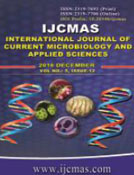


 National Academy of Agricultural Sciences (NAAS)
National Academy of Agricultural Sciences (NAAS)

|
PRINT ISSN : 2319-7692
Online ISSN : 2319-7706 Issues : 12 per year Publisher : Excellent Publishers Email : editorijcmas@gmail.com / submit@ijcmas.com Editor-in-chief: Dr.M.Prakash Index Copernicus ICV 2018: 95.39 NAAS RATING 2020: 5.38 |
The incidence of dengue has grown dramatically around the world in recent decades. The exact clinical and laboratory profile is crucial for diagnosis as well as successful management of the patients. This study is an attempt to assess the clinical and laboratory profile of serologically confirmed cases of dengue fever in a tertiary care hospital. This cross-sectional observational study was carried out including 45 dengue fever cases in a tertiary care teaching hospital. All patients above 18 years with confirmed dengue, who were either admitted in the medical wards of the hospital or managed as outdoor patients with NS1 (non-structural protein) antigen and/ or IgM dengue antibody positivity were included in the study. All the patients, who presented with fever and found positive Dengue IgM antibodies capture enzyme-linked immunosorbent assay (MAC-ELISA). The diagnosis of DF, DHF, and dengue shock syndrome (DSS) were based on the WHO criteria. Fever was documented in all 45 (100%) patients, the most common symptom followed by reduced appetite 41 (91.1%), myalgia 39 (86.7%), headache 36 (80%), abdominal pain 29 (64.4%), nausea/ vomiting 18 (40%), diarrhea 17 (37.8%) and pruritus 17 (37.8%). Bleeding manifestations occurred in 21 (46.7%) patients, of whom petechiae 17 (37.8%) was the most frequent followed by gum bleeding 5 (11.1%), gum bleeding 5 (11.1%). Ecchymosis 3 (6.7%), malena3 (6.7%) and hematuria 2 (4.4%) were less common. Fever associated with headache, retroorbital pain, erythematous morbilliform rash and itching in palms and soles along with thrombocytopenia, leucopenia, and elevated liver transaminases should prompt a clinician on the possibility of dengue infection. Proper confirmation of diagnosis, early institution of therapy, public awareness, and vector control are important factors to be taken into consideration in the prevention and management of dengue.
 |
 |
 |
 |
 |